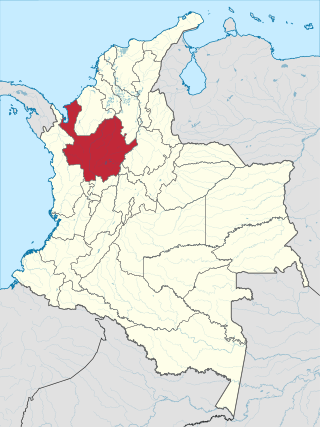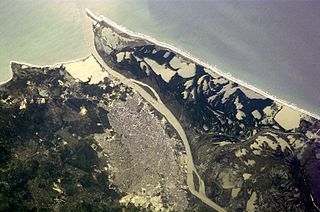| Total population | |
|---|---|
| 5,000 | |
| Regions with significant populations | |
| Bogotá | |
| Languages | |
| Spanish, Hebrew, Yiddish, Ladino | |
| Religion | |
| Judaism and Christianity |
| Part of a series on |
| Jews and Judaism |
|---|
The History of the Jews in Colombia begins in the Spanish colonial period with the arrival of the first Jews during the Spanish colonization of the Americas.
"New Christians", or Marranos, fled the Iberian peninsula to escape persecution and seek religious freedom during the 16th and 17th centuries. It is estimated that some reached northern areas of Colombia, which at the time was known as New Granada. Most if not all of these people assimilated into Colombian society. Some continue to practice Jewish rituals as family traditions.
In the 18th century, practicing Spanish and Portuguese Jews came from Jamaica and Curaçao, where they had flourished under English and Dutch rule. These Jews started practicing their religion openly in Colombia at the end of the 18th century, although it was not officially legal to do so, given the established Catholic Church. After independence, Judaism was recognized as a legal religion. The government granted the Jews land for a cemetery.
Many Jews who came during the 18th and 19th centuries achieved prominent positions in Colombian society. Some married local women and felt they had to abandon or diminish their Jewish identity. These included author Jorge Isaacs of English Jewish ancestry, the industrialist James Martin Eder (who adopted the more Christian name of Santiago Eder when he translated his name to Spanish) born into the Latvian Jewish community, as well as the De Lima, Salazar, Espinoza, Arias, Ramirez, Nunez, Lindo,Tafur, Lozano, Lerma, Vinasco, De Castro, Perez and Lobo families of Antillean Sephardim. Coincidentally, these persons and their families settled in the Cauca Valley region of Colombia. They have continued to be influential members of society in cities such as Cali, Palmira and Tulua. Over the generations most of their descendants were raised as secular Christians.
During the early part of the 20th century, numerous Sephardic Jewish immigrants came from Greece, Turkey, North Africa and Syria. Shortly after, Jewish immigrants began to arrive from Eastern Europe. A wave of Ashkenazi immigrants came after the rise of Nazism in 1933 and the imposition of anti-Semitic laws and practices, followed by as many as 17,000 German Jews. From 1939 until the end of World War II, immigration was put to a halt by anti-immigrant feelings in the country and restrictions on immigration from Germany. [1]
Colombia asked Germans who were on the U.S. blacklist to leave and allowed Jewish refugees in the country illegally to stay. [2] President Laureano Gómez actively supported and helped the Jewish Community through this troubling time.[ citation needed ] The Jewish population increased dramatically in the 1950s and 1960s, and institutions such as synagogues, schools and social clubs were established throughout the largest cities in the country. [3] Rabbi Eliezer Roitblatt was the first rabbi to arrive in Colombia in 1946, and served as its first Ashkenazi Chief Rabbi. [4] In the 1950s, a Sephardic Jewish community originating in particular from Syria, Turkey and Egypt was created with Rabbi David Sharbani serving as the Sephardic Chief Rabbi. [5]
A wave of kidnappings during the last decade of the 20th century led some members of Colombia's Jewish community to emigrate. Most settled in Miami and other parts of the United States. Successes in the nation's democratic security policy has encouraged citizens to return; it has drastically reduced violence in the rural areas and criminality rates in urban areas, as well as in spurring the economy.[ citation needed ] The situation in Colombia has improved to the extent that many Venezuelan Jews are now seeking refuge in Colombia.[ citation needed ]
In the department of Antioquia, as well as in the greater Paisa region, some families hold traditions and oral accounts of Jewish descent. In this population, Y-DNA genetic analysis has shown an origin of male founders predominantly from "southern Spain but also suggest that a fraction came from northern Iberia and that some possibly had a Sephardic origin". [6] Medellín has a tradition of the marranada, where a pig is slaughtered, butchered and consumed on the streets of every neighborhood each Christmas. This custom has been interpreted as an annual affirmation of the rejection of Jewish law. [7]
It was known that some Spanish and Portuguese New Christians of Sephardic Jewish ancestry fled the Cartagena de Indias Inquisition and took refuge in the Antioquian mountains during the sixteenth and seventeenth century. Some Colombian authors like Jorge Isaacs and Miguel Ángel Osorio have claimed that it is indisputable that Paisas have Jewish ancestry. Several Paisa surnames are known to have been prevalent among New Christian conversos of Sephardic Jewish origin, for example Espinosa, Pérez, Mejía, and many others.[ citation needed ]
Some scholars state that the presence of Sephardic Jews among the ancestors of Paisas is a fact, but it does not mean that all Paisas descend from them, nor that it is the only or predominant element among those that do, as is proven by the Paisas' descent from other groups like Basques, Extremadurans, and Andalusians. [8]
As of the 21st century, approximately 5,000 Jews live in Colombia. Most of them are concentrated in Bogotá, with about 3,500 members, and Cali, with about 1,000 members. New communities have sprung up in Barranquilla and Medellín. Very few Jews practice religious observance; among those who do, the majority are Orthodox. German Jewish communities in Bogota and Cali also preserve much of their traditions. [9]
Smaller communities are found in Cartagena and the island of San Andres. There are approximately 10 official synagogues throughout the country. In Bogotá, the Ashkenazi, Sephardic, and German Jews each run their own religious and cultural institutions. The Confederación de Asociaciones Judías de Colombia, located in Bogotá, is the central organization that coordinates Jews and Jewish institutions in Colombia.
In the new millennium, after years of study, a group of Colombians with Jewish ancestry formally converted to Judaism in order to be accepted as Jews according to the rabbinical interpretation of the halakha. [10]

SephardicJews, also known as Sephardi Jews or Sephardim, and rarely as Iberian Peninsular Jews, are a Jewish diaspora population associated with the Iberian Peninsula. The term, which is derived from the Hebrew Sepharad, can also refer to the Jews of the Middle East and North Africa, who were also heavily influenced by Sephardic law and customs. Many Iberian Jewish exiled families also later sought refuge in those Jewish communities, resulting in ethnic and cultural integration with those communities over the span of many centuries.

Antioquia is one of the 32 departments of Colombia, located in the central northwestern part of Colombia with a narrow section that borders the Caribbean Sea. Most of its territory is mountainous with some valleys, much of which is part of the Andes mountain range. Antioquia has been part of many territorial divisions of former countries created within the present-day territory of Colombia. Prior to adoption of the Colombian Constitution of 1886, Antioquia State had its own sovereign government.

Crypto-Judaism is the secret adherence to Judaism while publicly professing to be of another faith; practitioners are referred to as "crypto-Jews".

Medellín, officially the Special District of Science, Technology and Innovation of Medellín, is the second-largest city in Colombia after Bogotá, and the capital of the department of Antioquia. It is located in the Aburrá Valley, a central region of the Andes Mountains, in northwestern South America. The city's population was 2,508,452 at the 2018 census. The metro area of Medellín is the second-largest urban agglomeration in Colombia in terms of population and economy, with more than 4 million people.

Atlético Nacional S. A., best known as Atlético Nacional, is a Colombian professional football club based in Medellín. The club is one of only three clubs to have played in every first division tournament in the country's history, the other two being Millonarios and Santa Fe.
The history of the Jews in Latin America began with conversos who joined the Spanish and Portuguese expeditions to the continents. The Alhambra Decree of 1492 led to the mass conversion of Spain's Jews to Catholicism and the expulsion of those who refused to do so. However, the vast majority of conversos never made it to the New World and remained in Spain slowly assimilating to the dominant Catholic culture. This was due to the requirement by Spain's Blood Statutes to provide written documentation of Old Christian lineage to travel to the New World. However, the first Jews came with the first expedition of Christopher Columbus, including Rodrigo de Triana and Luis De Torres.

A Paisa is someone from a region in the northwest of Colombia, including part of the West and Central cordilleras of the Andes in Colombia. The Paisa region is formed by the departments of Antioquia, Caldas, Risaralda and Quindío. Some regions of Valle del Cauca Department (north) and Tolima Department (west) culturally identify as paisas. The main cities of the Paisa region are Medellín, Pereira, Manizales and Armenia.

Tomás Carrasquilla Naranjo (1858 – 1940) was a Colombian writer who lived in the Antioquia region. He dedicated himself to very simple jobs: tailor, secretary of a judge, storekeeper in a mine, and worker at the Ministry of Public Works. He was an avid reader, and one of the most original Colombian literary writers, greatly influencing the younger generation of his time and later generations. Carrasquilla was little known in his time, according to Federico de Onís, a scholar of Carrasquilla's works. It was only after 1936, when he was already 78 years old, when he was awarded with the National Prize of Literature, that Carrasquilla got a national recognition. Tomás Carrasquilla Library Park is named in his honor.

Bandeja paisa, with variations known as bandeja de arriero, bandeja montañera, or bandeja antioqueña, is one of the most representative meals in Colombian cuisine, especially of the Antioquia department and the Paisa Region, as well as with the Colombian Coffee-Growers Axis, and part of Valle del Cauca and the northwest of Tolima.

Colombians are people identified with the country of Colombia. This connection may be residential, legal, historical or cultural. For most Colombians, several of these connections exist and are collectively the source of their being Colombian.

The history of the Jews in Mexico began in 1519 with the arrival of Conversos, often called Marranos or "Crypto-Jews", referring to those Jews forcibly converted to Catholicism and that then became subject to the Spanish Inquisition.

The Sephardic Jews that were exiled from Spain and the Mediterranean area in 1492 and 1497, coupled with other migrations dating from the 1700s and during World War II contributed to Dominican ancestry.

Colombian Spanish is a grouping of the varieties of Spanish spoken in Colombia. The term is of more geographical than linguistic relevance, since the dialects spoken in the various regions of Colombia are quite diverse. The speech of the northern coastal area tends to exhibit phonological innovations typical of Caribbean Spanish, while highland varieties have been historically more conservative. The Caro and Cuervo Institute in Bogotá is the main institution in Colombia to promote the scholarly study of the language and literature of both Colombia and the rest of Spanish America. The educated speech of Bogotá, a generally conservative variety of Spanish, has high popular prestige among Spanish-speakers throughout the Americas.

Immigration to Colombia during the early 19th and late 20th Century, is what makes it one of the most diverse countries in the world, above other countries in the Latin region. Colombia inherited from the Spanish Empire harsh rules against immigration, first in the Viceroyalty of New Granada and later in the Colombian Republic. The Constituent Assembly of Colombia and the subsequent reforms to the national constitution were much more open to the immigrants and the economic aperture. However naturalization of foreigners, with the exception of those children of Colombians born abroad, it is still difficult to acquire due 'Jus soli' law is not allowed by the government, and only 'Jus sanguinis' law is accepted. Immigration in Colombia is managed by the "Migración Colombia" agency.
The history of the Jews in Costa Rica dates back to the Spanish conquest with the arrival of many Sephardic converts known as Marranos who escaped from the Spanish Inquisition and settled mainly in the city of Cartago and its surroundings. They hid their Jewish past by all means, making even their descendants have no idea of it.
White Colombians are the Colombian descendants of European and Middle Eastern people living in Colombia. According to the 2018 census, 87.58% of Colombians do not identify with any ethnic group, thus being either white or mestizo, which are not categorized separately.
Race and ethnicity in Colombia descend mainly from three racial groups—Europeans, Amerindians, and Africans—that have mixed throughout the last 500 years of the country's history. Some demographers describe Colombia as one of the most ethnically diverse countries in the Western Hemisphere and in the World, with 900 different ethnic groups. Most Colombians identify themselves and others according to ancestry, physical appearance, and sociocultural status. Social relations reflect the importance attached to certain characteristics associated with a given racial group. Although these characteristics no longer accurately differentiate social categories, they still contribute to one's rank in the social hierarchy. A study from Rojas et al involving 15 departments determined that the average Colombian has a mixture of 47% Amerindian 42% European, and 11% African. These proportions also vary widely among ethnicities.
Sephardic Bnei Anusim is a modern term which is used to define the contemporary Christian descendants of an estimated quarter of a million 15th-century Sephardic Jews who were coerced or forced to convert to Catholicism during the 14th and 15th centuries in Spain and Portugal. The vast majority of conversos remained in Spain and Portugal, and their descendants, who number in the millions, live in both of these countries. The small minority of conversos who emigrated normally chose to emigrate to destinations where Sephardic communities already existed, particularly to the Ottoman Empire and North Africa, but some of them emigrated to more tolerant cities in Europe, where many of them immediately reverted to Judaism. In theory, very few of them would have traveled to Latin America with colonial expeditions, because only those Spaniards who could certify that they had no recent Muslim or Jewish ancestry were supposed to be allowed to travel to the New World. Recent genetic studies suggest that the arrival of the Sephardic ancestors of Latin American populations coincided with the initial colonization of Latin America, which suggests that significant numbers of recent converts were able to travel to the new world and contribute to the gene pool of modern Latin American populations despite an official prohibition on them doing so. In addition, later arriving Spanish immigrants would have themselves contributed additional converso ancestry in some parts of Latin America.
German Colombians are Colombian citizens of German ancestry. They may be descendants of Germans who immigrated to Colombia from Germany or elsewhere in Europe. Most German Colombians live in the departments of Andean Region and Caribbean Region. Germans have been immigrating to Colombia since at least 16th century. During World War II, thousands of Germans fled to Colombia.

Italian Colombians are Colombian-born citizens who are fully or partially of Italian descent, whose ancestors were Italians who emigrated to Colombia during the Italian diaspora, or Italian-born people in Colombia. Italians have been immigrating to Colombia since the early 16th century.